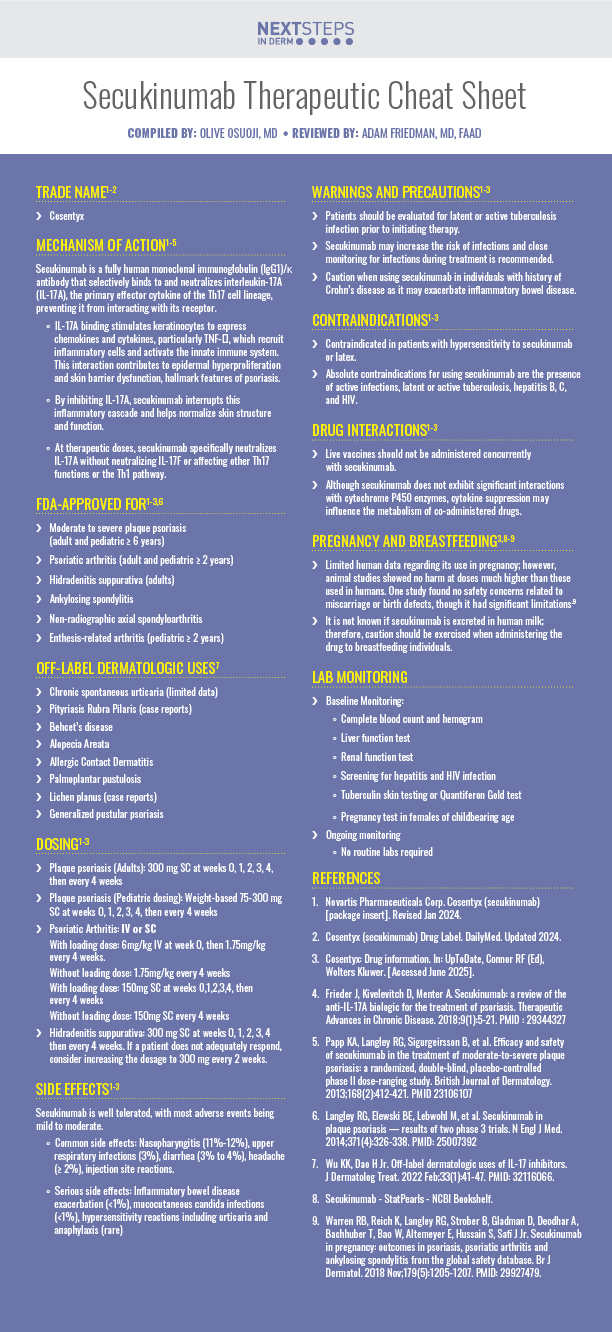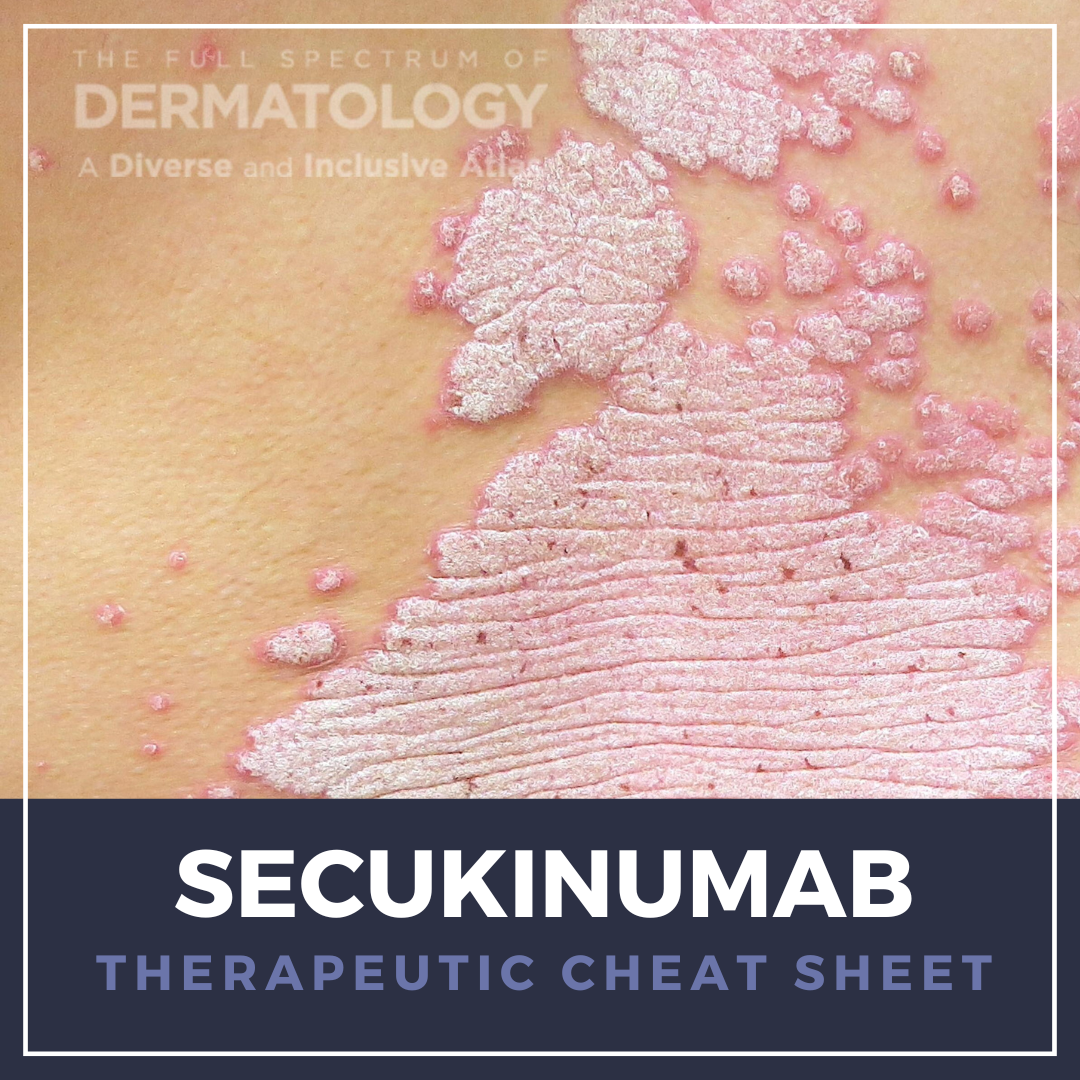Secukinumab is a recombinant human monoclonal immunoglobulin IgG1κ antibody that selectively targets interleukin-17A (IL-17A), a key effector cytokine in the Th17 pathway implicated in the pathogenesis of psoriasis. With its high target specificity, rapid onset, sustained efficacy, and favorable safety profile, secukinumab has become a mainstay in the treatment of psoriasis and other inflammatory dermatoses. We continue our series, Therapeutic Cheat Sheet, with a closer look at Secukinumab.
Secukinumab Therapeutic Cheat Sheet
Compiled by: Olive Osuoji, MD | Reviewed by: Adam Friedman, MD
TRADE NAME1-2
-
- Cosentyx
MECHANISM OF ACTION1-5
Secukinumab is a fully human monoclonal immunoglobulin (IgG1)/κ antibody that selectively binds to and neutralizes interleukin-17A (IL-17A), the primary effector cytokine of the Th17 cell lineage, preventing it from interacting with its receptor.
-
- IL-17A binding stimulates keratinocytes to express chemokines and cytokines, particularly TNF-α, which recruit inflammatory cells and activate the innate immune system. This interaction contributes to epidermal hyperproliferation and skin barrier dysfunction, hallmark features of psoriasis.
- By inhibiting IL-17A, secukinumab interrupts this inflammatory cascade and helps normalize skin structure and function.
- At therapeutic doses, secukinumab specifically neutralizes IL-17A without neutralizing IL-17F or affecting other Th17 functions or the Th1 pathway.
FDA APPROVED FOR1-3, 6
-
- Moderate to severe plaque psoriasis (adult and pediatric ≥ 6 years)
- Psoriatic arthritis (adult and pediatric ≥ 2 years)
- Hidradenitis suppurativa (adults)
- Ankylosing spondylitis
- Non-radiographic axial spondyloarthritis
- Enthesis-related arthritis (pediatric ≥ 2 years)
OFF-LABEL DERMATOLOGIC USES7
-
- Chronic spontaneous urticaria (limited data)
- Pityriasis Rubra Pilaris (case reports)
- Behcet’s disease
- Alopecia Areata
- Allergic Contact Dermatitis
- Palmoplantar pustulosis
- Lichen planus (case reports)
- Generalized pustular psoriasis
DOSING1-3
-
- Plaque psoriasis (Adults): 300 mg SC at weeks 0, 1, 2, 3, 4, then every 4 weeks
-
- Plaque psoriasis (Pediatric dosing): Weight-based 75-300 mg SC at weeks 0, 1, 2, 3, 4, then every 4 weeks
-
- Psoriatic Arthritis: IV or SC
- With loading dose: 6mg/kg IV at week 0, then 1.75mg/kg every 4 weeks.
- Without loading dose: 1.75mg/kg every 4 weeks
- With loading dose: 150mg SC at weeks 0,1,2,3,4, then every 4 weeks
- Without loading dose: 150mg SC every 4 weeks
- Psoriatic Arthritis: IV or SC
-
- Hidradenitis suppurativa: 300 mg SC at weeks 0, 1, 2, 3, 4 then every 4 weeks. If a patient does not adequately respond, consider increasing the dosage to 300 mg every 2 weeks.
SIDE EFFECTS1-3
Secukinumab is well tolerated, with most adverse events being mild to moderate.
-
- Common side effects: Nasopharyngitis (11%-12%), upper respiratory infections (3%), diarrhea (3% to 4%), headache (≥ 2%), injection site reactions.
- Serious side effects: Inflammatory bowel disease exacerbation (<1%), mucocutaneous candida infections (<1%), hypersensitivity reactions including urticaria and anaphylaxis (rare)
WARNINGS AND PRECAUTIONS1-3
-
- Patients should be evaluated for latent or active tuberculosis infection prior to initiating therapy.
- Secukinumab may increase the risk of infections and close monitoring for infections during treatment is recommended.
- Caution when using secukinumab in individuals with history of Crohn’s disease as it may exacerbate inflammatory bowel disease.
CONTRAINDICATIONS1-3
-
- Contraindicated in patients with hypersensitivity to secukinumab or latex.
- Absolute contraindications for using secukinumab are the presence of active infections, latent or active tuberculosis, hepatitis B, C, and HIV.
DRUG INTERACTIONS1-3
-
- Live vaccines should not be administered concurrently with secukinumab.
- Although secukinumab does not exhibit significant interactions with cytochrome P450 enzymes, cytokine suppression may influence the metabolism of co-administered drugs.
PREGNANCY AND BREASTFEEDING3,8-9
-
- Limited human data regarding its use in pregnancy; however, animal studies showed no harm at doses much higher than those used in humans. One study found no safety concerns related to miscarriage or birth defects, though it had significant limitations.9
- It is not known if secukinumab is excreted in human milk; therefore, caution should be exercised when administering the drug to breastfeeding individuals.
LAB MONITORING
-
- Baseline Monitoring:
- Complete blood count and hemogram
- Liver function test
- Renal function test
- Screening for hepatitis and HIV infection
- Tuberculin skin testing or Quantiferon Gold test
- Pregnancy test in females of childbearing age
- Baseline Monitoring:
-
- Ongoing monitoring
- No routine labs required

FURTHER READING
If you would like to learn more about secukinumab, check out the following articles in the Journal of Drugs in Dermatology:
Gutierrez E, Issa N, Resnik B
Abstract
Hidradenitis suppurativa (HS) is a morbid, recurrent skin condition that presents a major challenge to clinical therapy. Investigation into the pathogenesis of HS has implicated local and systemic pro-inflammatory cytokines, particularly TNF-α and IL-17A, as major determinants of disease progression and severity. This has ushered in a revolution in HS therapy with biologics targeting these cytokines. We report a case of a 36-year-old man with extensive and treatment resistant Hurley Stage 3 HS. After undergoing numerous unsuccessful trials of topical, systemic, and biologic therapies, secukinumab therapy with 150 mg weekly injections was initiated. HS clinical response was seen after 20 weeks and was maintained for almost two years.
Secukinumab 150 mg or 300 mg once weekly may be an effective and safe therapeutic option for moderate-to-severe chronic HS.
J Drugs Dermatol. 2022;21(12):1358-1360.
El-Kashlan N, Cices A, Kaufman B et al
Abstract
Background: There is a paucity of data on the treatment of psoriasis in patients with skin of color – a diverse population among whom variations in clinical features and higher quality of life impact have been reported. This single-center, open-label clinical study evaluated the safety and efficacy of secukinumab in the treatment of moderate-to-severe plaque psoriasis in adults with Fitzpatrick skin types IV-VI.
Methods: A total of 20 male and female subjects (ages 18 or older, BSA 10% or greater, PASI Score 12 or greater, IGA 3 or greater) completed this study. The total study duration was 28 weeks. During the treatment period, subjects received secukinumab 300 mg subcutaneously at weeks 0, 1, 2, 3, and 4, then monthly through week 20.
Results: 73% of patients achieved at least 90% improvement in PASI score (PASI90) at week 16 compared to baseline (P=0.0592). There was a statistically significant proportion of patients achieving PASI75, IGA of clear or almost clear, and a change from baseline in DLQI total score at weeks 12, 16, and 24. A statistically significant reduction in IGAxBSA-75 score was achieved between week 16 and baseline.
Limitations: The sample size was small and underpowered to detect statistically significant changes in some endpoints. Furthermore, the study period was interrupted by the COVID-19 pandemic, which contributed to numerous missing data points.
Conclusion: Secukinumab 300 mg administered monthly was safe, well-tolerated, and efficacious in treating skin of color patients with psoriasis and improving health-related quality of life. Larger studies involving skin of color populations with psoriasis are warranted.
J Drugs Dermatol. 2024;23(8):600-606.
Secukinumab: Long-term Safety and Efficacy in Psoriasis
Hashim PW, Lebowhl MG, Kircik, LH
REFERENCES
-
- Novartis Pharmaceuticals Corp. Cosentyx (secukinumab) [package insert]. Revised Jan 2024.
- Cosentyx (secukinumab) Drug Label. DailyMed. Updated 2024.
- Cosentyx: Drug information. In: UpToDate, Connor RF (Ed), Wolters Kluwer. [Accessed June 2025].
- Frieder J, Kivelevitch D, Menter A. Secukinumab: a review of the anti-IL-17A biologic for the treatment of psoriasis. Therapeutic Advances in Chronic Disease. 2018;9(1):5-21. PMID : 29344327
- Papp KA, Langley RG, Sigurgeirsson B, et al. Efficacy and safety of secukinumab in the treatment of moderate-to-severe plaque psoriasis: a randomized, double-blind, placebo-controlled phase II dose-ranging study. British Journal of Dermatology. 2013;168(2):412-421. PMID 23106107
- Langley RG, Elewski BE, Lebwohl M, et al. Secukinumab in plaque psoriasis — results of two phase 3 trials. N Engl J Med. 2014;371(4):326-338. PMID: 25007392
- Wu KK, Dao H Jr. Off-label dermatologic uses of IL-17 inhibitors. J Dermatolog Treat. 2022 Feb;33(1):41-47. PMID: 32116066.
- Secukinumab – StatPearls – NCBI Bookshelf
- Warren RB, Reich K, Langley RG, Strober B, Gladman D, Deodhar A, Bachhuber T, Bao W, Altemeyer E, Hussain S, Safi J Jr. Secukinumab in pregnancy: outcomes in psoriasis, psoriatic arthritis and ankylosing spondylitis from the global safety database. Br J Dermatol. 2018 Nov;179(5):1205-1207. PMID: 29927479.
Did you enjoy this Therapeutic Cheat Sheet? You can find more here.

